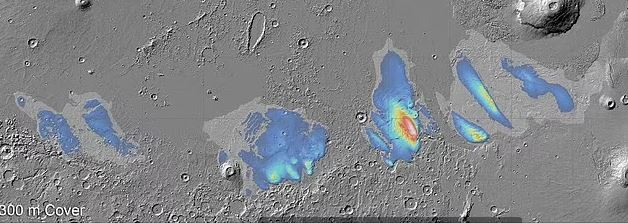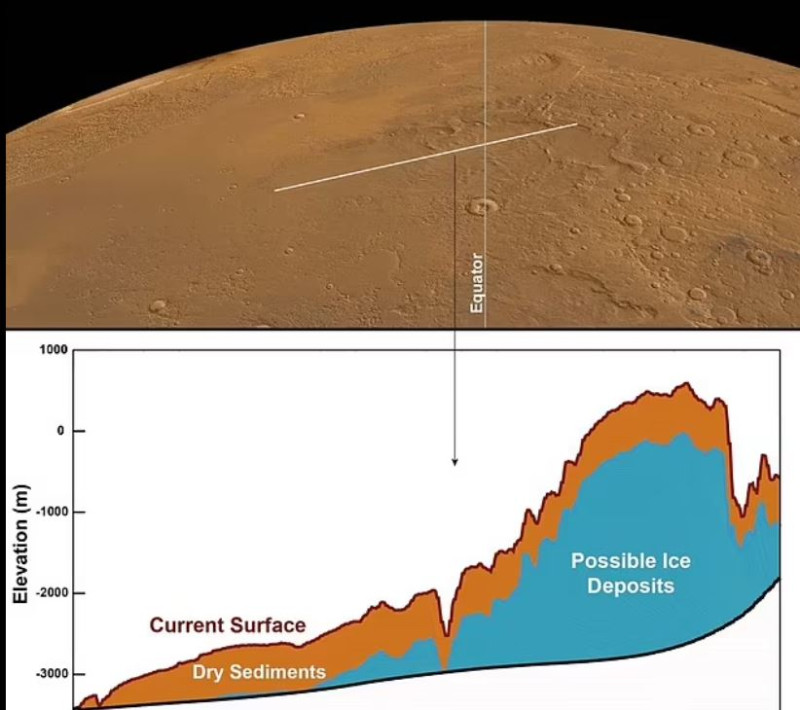This is the largest amount of water ever found in this part of the planet
Buried water ice at its equator Marsfound by the mission ESA’s Mars Express , a veteran spacecraft that has been engaged in scientific operations around Mars for 20 years. While not the first time evidence of ice has been found near the Red Planet’s equator, this new discovery is by far the largest amount of water ice detected there so far and appears to match previous discoveries of water ice on Mars.
“Excitingly, the radar signals match what we expect to see from layered ice and are similar to the signals we see from the polar caps of Mars, which we know are very ice-rich,” said the lead researcher. Thomas Watters of the Smithsonian Institution.
The thickness of the deposits is 3.7 kilometers, which suggests ice in layers, as in the known polar caps of Marswhich we know are very ice-rich.
15 years ago, the Mars Express studied the Medusae Fossae formation, revealing huge deposits, up to 2.5 kilometers deep. From these early observations, the composition of the deposits was not clear, but now through new research answers are being provided.
If the amount of ice present in Medusae Fossae melts, it could cover the entire planet with a layer of water 1.5 to 2.7 meters deep, an amount the size of Red Sea on earth.
Although melting the ice may require an ambitious drilling operation when astronauts land on the Marscould potentially be used for consumption or cultivation.
THE Medusae Fossae Formation is a collection of massive deposits that stretch for about 5,000 kilometers (3,107 mi) along the Martian equator, marking the boundary between the plains in the northern hemisphere and the cratered highlands in the south.
Scientists don’t know what created the deposits, but they are huge, standing several kilometers high, sculpted by the fierce winds that sweep across the Martian surface.
If the formation consisted only of dust, it would have been compressed by its own weight, increasing its density. But the new data show that its density is consistent with the existence of layers of dust and water ice, beneath a protective layer of dust or ash several hundreds of meters thick.
More relevant is the question of how the water ice ended up buried at the equator. Subsurface ice has been found in abundant quantities on Mars in the past. NASA’s Phoenix mission dug up ice just below the dusty surface in the lander’s polar landing region in 2008. Meanwhile, early in its mission, Mars Express spotted abundant water-ice extending into the mid-latitudes, and Mars Odyssey her NASA even found evidence of the presence of water in the AMF in 2009.
More recently, the ESA’s Trace Gas Orbiter detected hydrogen from water ice just below the surface of Candor Chaos, which is part of the huge rift in the surface of Mars that we call Vallis Marineris. Additionally, the remains of ancient glaciers, called relict glaciers, have been identified in the eastern Noctis Labyrinth, which lies just 7.3 degrees south of the equator.
The presence of subsurface water-ice at low and equatorial latitudes suggests how the Martian climate was very different in the distant past.
Source :Skai
I am Terrance Carlson, author at News Bulletin 247. I mostly cover technology news and I have been working in this field for a long time. I have a lot of experience and I am highly knowledgeable in this area. I am a very reliable source of information and I always make sure to provide accurate news to my readers.












